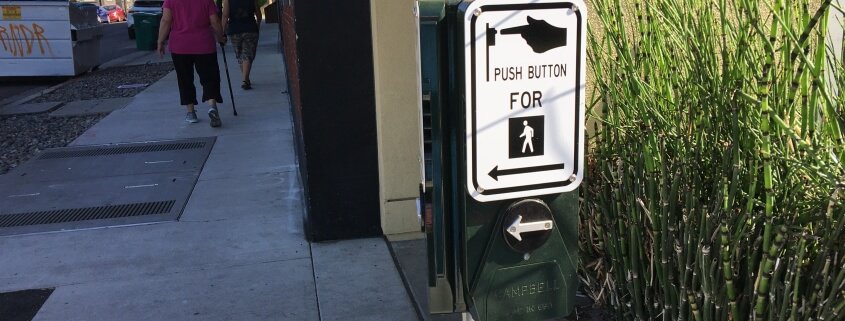Begging Off Beg Buttons
Pedestrian push buttons are the bain of walkers everywhere. You push it and wait for the walk signal. And wait. And wait. Many pedestrians assume the button is broken (or don’t know they need to push a button) and cross against the light. This unpleasant brainchild of car-first engineering is called the “beg” button for good reason: people in cars pass freely, while those on foot must beg for the privilege of crossing the road.
As we all work to stay infection-free during the coronavirus pandemic, beg buttons have become a new threat. It’s hazardous to force pedestrians to touch a surface that many others have also touched. As a result, some California cities have temporarily disabled some or all beg buttons, replacing them with light timing that automatically includes pedestrian cycles and walk signals. On the other hand, officials in some cities still refuse to turn off the buttons, despite the increased risk due to COVID-19.
The need to disable beg buttons for infection control will not be transient. As California loosens the stay at home guidelines and people begin to move around more, we will need to be even more careful not to touch surfaces in public places.
Even when the concern for infection dissipates, we should remove beg buttons from California streets. CalBike is ready to throw our support behind local and statewide campaigns to help planners understand why they should #banbegbuttons.
Beg buttons penalize people for walking
Before beg buttons were invented, city engineers would program the lights to switch from green to red and back again on a cycle that promotes the flow of traffic. Each cycle had to include a pedestrian walk phase in each direction; there was no other way for pedestrians to get the all-clear to cross the street.
In an intersection with a beg button, engineers program the traffic signals for cars without regard to people needing to walk across the street. Some green cycles may be so short that a pedestrian has no chance to cross, unless they press a button.
This presents a barrier to walking in several different ways:
- Pedestrians have to wait much longer for a walk signal. If your walk includes multiple beg buttons, this can substantially increase the time it takes to get to your destination. This creates a disincentive for walking.
- Pedestrians often have to wait even when the light is green for cars in the direction they want to cross. A green light for phase for cars may display a red hand for pedestrians unless you push a button. If you push the button in the middle of a green phase for cars, you usually have to wait another full cycle before getting a walk signal.
- Beg buttons are often hard to access, especially for people with disabilities and mobility issues. Engineers often install a beg button on the nearest pole, which may not be near the crosswalk. Beg buttons frequently violate ADA guidelines.
- People often get frustrated with beg buttons or don’t realize they need to push them. Then they cross against the light, putting themselves in danger.
Beg buttons help car drivers by inconveniencing and slowing down walkers. Every time a city installs new beg buttons, that is a physical representation of prioritization of cars and disregard for pedestrians.
Beg buttons are bad for bikes, too
Beg buttons don’t only increase the burden on walkers. They also make it many orders of magnitude harder for bikes to navigate intersections.
- Bicyclists often ride on quieter streets, so they may often end up waiting through long cycles at intersections.
- Loop detectors in the pavement should detect bikes, but they often don’t. Even if they were adjusted to be sensitive enough to pick up a bike, cars passing over the pavement can throw the detectors off. When that happens, bike riders either have to wait for a car to turn the light or dismount and push a beg button.
- Signal detection cameras are somewhat more able to pick up bikes than in-pavement detectors, but they are prone to adjustment problems as well. Grime on the camera lens can prevent them from sensing bikes.
When cities turn beg buttons off, the light cycles from red to green and back again. Everyone gets a turn without hassle: bike riders, walkers, and car drivers.
Local advocates ask cities to #BanBegButtons
There is a small but growing movement to rid California intersections of beg buttons permanently. So far, the action has been at the city level. CalBike supports these local efforts. We will stand with our advocacy partners if a statewide effort seems appropriate in the future.
It’s time to stop penalizing pedestrians and bicyclists. California cities need to #BanBegButtons now!





